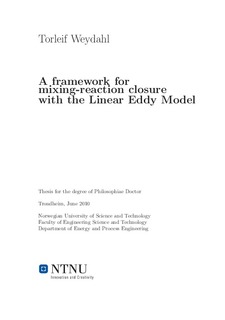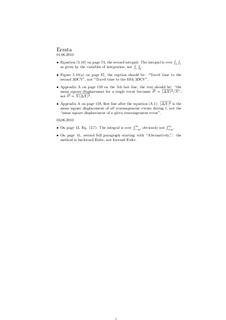| dc.contributor.advisor | Gran, Inge R. | nb_NO |
| dc.contributor.advisor | Sannan, Sigurd | nb_NO |
| dc.contributor.advisor | Ertesvåg, Ivar S. | nb_NO |
| dc.contributor.author | Weydahl, Torleif | nb_NO |
| dc.date.accessioned | 2014-12-19T11:44:08Z | |
| dc.date.available | 2014-12-19T11:44:08Z | |
| dc.date.created | 2010-08-12 | nb_NO |
| dc.date.issued | 2010 | nb_NO |
| dc.identifier | 343242 | nb_NO |
| dc.identifier.isbn | 978-82-471-2062-0 | nb_NO |
| dc.identifier.uri | http://hdl.handle.net/11250/233521 | |
| dc.description.abstract | This thesis presents a novel framework for mixing-reaction closure build on the Linear Eddy Model by Kerstein (1991B). The development of the modeling concept has been motivated by the need for better predictive tools for turbulent combustion. Such tools are essential in the design of combustion technology with reduced emissions and improved efficiency, and in the development of new combustor configurations, e.g. for CO2 capture. The original standalone Linear Eddy Model (LEM) is based on a phenomenological description of turbulent mixing on a one-dimensional domain, which can be considered to be a line of sight through the turbulent flow. LEM treats the three-dimensional advective turbulent stirring by one-dimensional stochastic re-arrangements, while the diffusive molecular mixing and the chemical reactions are solved directly.
The new framework, denoted LEM3D, extends the capabilities of the standalone LEM by creating a Cartesian three-dimensional structure of LEM domains coupled to a flow solver. Mean flow scalar advection is implemented by discrete Lagrangian displacements of LEM cells. Directional coupling is provided by random rotations of intersecting sections of LEM cells, which define a supergrid. Thermal expansions are performed by discrete dilatations. A detailed description of each part of the framework is presented in this thesis.
The present work has been forcused on assessing LEM3D through a number of relatively simple test cases. It is found that the random rotations introduce additional dispersion and anhance molecular diffusion. The random rotaions also cause a relatively broad distribution of travel times for a scalar through the domain.
Even though the displacements in LEM3D on average represents the prescribed velocity field, the discrete fluid cell treatment causes instantaneous deviations. A method which corrects the displacements in order to reduce these deviations has been developed.
LEM3D has also been developed to handle reacting flows by introducing discrete dilatations of LEM cells and coupling of LEM3D to a solver for the Reynolds-averaged Navier Stokes (RANS) equations. The mean density field is supplied from LEM3D to RANS, and RANS provides the updated velocity field to LEM3D. This approach leads to artifacts, due to the matching of the non-conservative velocities. Suggestions for future work are presented based on these results.
LEM3D has been further discussed by comparing results from a reduced dimensional version of the model (LEM2D) with experimental data from a line source in homogeneous turbulence by Warhaft (1984). The full-featured non-reacting LEM3D simulations are promising considering the rather early stage of development. | nb_NO |
| dc.language | eng | nb_NO |
| dc.publisher | NTNU | nb_NO |
| dc.relation.ispartofseries | Doktoravhandlinger ved NTNU, 1503-8181; 2010:53 | nb_NO |
| dc.title | A framework for mixing-reaction closure with the Linear Eddy Model | nb_NO |
| dc.type | Doctoral thesis | nb_NO |
| dc.contributor.department | Norges teknisk-naturvitenskapelige universitet, Fakultet for ingeniørvitenskap og teknologi, Institutt for energi- og prosessteknikk | nb_NO |
| dc.description.degree | PhD i energi- og prosessteknikk | nb_NO |
| dc.description.degree | PhD in Energy and Process Engineering | en_GB |

